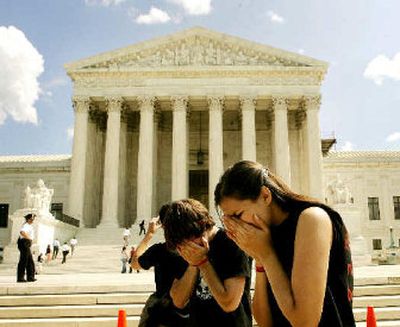Opening gears up battle over nomination

Now that there are two Supreme Court seats to fill, a relatively quiet debate among interest groups is expected to become the more bitter, multimillion-dollar slugfest opposing sides have long anticipated.
“Watch for World War III,” conservative lawyer John Hinderaker wrote Monday on Power Line, his widely read Web log.
Interest groups plan to ramp up their rhetoric, TV ad campaigns and grass-roots lobbying even though Chief Justice William Rehnquist’s death may not fundamentally change the court.
If President Bush gets his way in the Senate, Rehnquist will be replaced by another conservative – federal judge John Roberts. “That doesn’t turn the court to the right,” said Mark Hurwitz of Western Michigan University.
The vacancy Roberts had previously been tapped to fill, the seat of retiring Justice Sandra Day O’Connor, offers the better opportunity for Bush to at least slightly affect the balance on the court.
O’Connor is a moderate on some social issues. Hers is one of six votes on the nine-member panel to support abortion rights.
Before Rehnquist’s death on Saturday, Roberts’ nomination to fill O’Connor’s seat had generated relatively little heat. Progress for America, a conservative group that pledged to spend up to $18 million to support Bush’s nominee, had spent just a few million dollars.
Leading liberal groups such as People for the American Way, Alliance for Justice and NARAL Pro-Choice America had announced their opposition to Roberts’ confirmation. But among those, only NARAL had run anti-Roberts TV ads.
Overall, efforts by the White House, Republican Party officials and conservative groups to portray Roberts as a “fair” judge who deserved a “fair,” up-or-down vote in the Senate had dampened debate.
Things changed with the prospect of two court openings:
•Ralph Neas, president of People for the American Way, said in a statement that Roberts’ “hostility” to laws that many in the left view as guarding Americans from discrimination makes him “unfit for the position of chief justice.” Neas promised his group will “vigorously oppose his confirmation.”
In an interview, Neas said stakes are higher now because as chief justice, Roberts, 50, “could have a tremendous impact on the judiciary well into the 21st century.”
•Nancy Keenan, president of NARAL Pro-Choice America, called on the White House to release documents written by Roberts when he was a deputy solicitor general in the first Bush administration. “The American people need to know where this man stands on the issue of privacy,” Keenan said.
As for the O’Connor vacancy, Neas and Keenan called on Bush to choose a moderate, “consensus” nominee. C. Michael Comiskey, political science professor at Penn State Fayette, said that’s unlikely. Bush may be riding low in polls, but “I don’t think he’s afraid of a fight,” Comiskey said. “He’s going to nominate the person he wants.”
Interest groups on the right said they are ready to support the president’s nominees. “The left is doing its predictable show of hysterical scare-mongering,” said Sean Rushton, executive director of the conservative Committee for Justice.
“We’ll defend and promote the nominees,” said Brian McCabe, president of Progress for America.
The groups “have no reason to exist and collect money if they don’t fight on this now,” said Hinderaker, the conservative blogger.